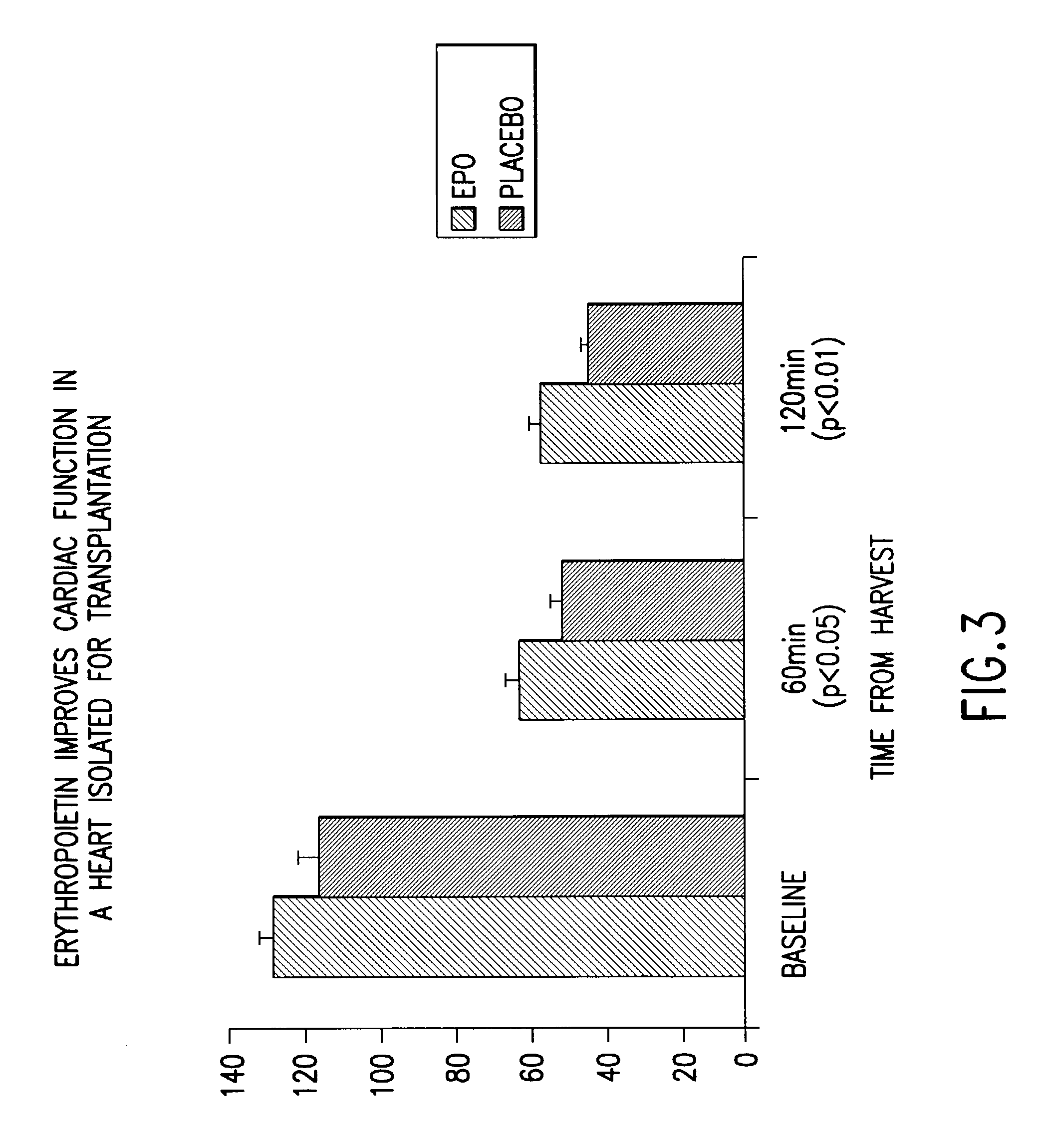Protection, restoration, and enhancement of erythropoietin-responsive cells, tissues and organs
a technology of erythropoietin and erythropoietin, which is applied in the direction of peptide/protein ingredients, extracellular fluid disorder, peptide sources, etc., can solve the problems of especially for normal individuals, and inability to use intracranial administration. achieve the effect of facilitating the transcytosis of molecules and reducing carbohydrate conten
- Summary
- Abstract
- Description
- Claims
- Application Information
AI Technical Summary
Benefits of technology
Problems solved by technology
Method used
Image
Examples
example 1
Erythropoietin Crosses the Blood-Cerebrospinal Fluid Tight Barrier
[0179]Adult male Sprague-Dawley rats were anesthetized and administered recombinant human erythropoietin intraperitoneally. Cerebrospinal fluid was sampled from the cisterna magna at 30 minute intervals up to 4 hrs and the erythropoietin concentration determined using a sensitive and specific enzyme-linked immunoassay. As illustrated in FIG. 1, the baseline erythropoietin concentration in CSF is 8 mU / ml. After a delay of several hours, the levels of erythropoietin measured in the CSF begin to rise and by 2.5 hours and later are significantly different from the baseline concentration at the p<0.01 level. The peak level of about 100 mU / ml is within the range known to exert protective effects in vitro (0.1 to 100 mU / ml). The time to peak occurs at about 3.5 hrs, which is delayed significantly from the peak serum levels (less than 1 hr). The results of this experiment illustrate that significant levels of erythropoietin c...
example 2
Maintenance of Function in Heart Prepared for Transplantation
[0180]Wistar male rats weighing 300 to 330 g are given erythropoietin (5000 U / kg body weight) or vehicle 24 h prior to removal of the heart for ex vivo studies, done in accordance with the protocol of Delcayre et al., 1992, Amer. J. Physiol. 263:H1537-45. Animals are sacrificed with pentobarbital (0.3 mL), and intravenously heparinized (0.2 mL). The hearts are initially allowed to equilibrate for 15 min The left ventricular balloon is then inflated to a volume that gives an end-diastolic pressure of 8 mm Hg. A left ventricular pressure-volume curve is constructed by incremental inflation of the balloon volume by 0.02 ml aliquots. Zero volume is defined as the point at which the left ventricular end-diastolic pressure is zero. On completion of the pressure-volume curve, the left ventricular balloon is deflated to set end-diastolic pressure back to 8 mmHg and the control period is pursued for 15 min, after check of coronary ...
example 3
Erythropoietin Protects Myocardium from Ischemic Injury
[0182]Adult male rats given recombinant human erythropoietin (5000 U / kg body weight) 24 hrs previously are anesthetized and prepared for coronary artery occlusion. An additional dose of erythropoietin is given at the start of the procedure and the left main coronary artery occluded for 30 minutes and then released. The same dose of erythropoietin is given daily for one week after treatment. The animals are then studied for cardiac function. As FIG. 3 illustrates, animals receiving a sham injection (saline) demonstrated a large increase in the left end diastolic pressure, indicative of a dilated, stiff heart secondary to myocardial infarction. In contradistinction, animals receiving erythropoietin suffered no decrement in cardiac function, compared to sham operated controls (difference significant at the p<0.01 level).
PUM
| Property | Measurement | Unit |
|---|---|---|
| pH | aaaaa | aaaaa |
| particle size | aaaaa | aaaaa |
| pH | aaaaa | aaaaa |
Abstract
Description
Claims
Application Information
 Login to View More
Login to View More - R&D
- Intellectual Property
- Life Sciences
- Materials
- Tech Scout
- Unparalleled Data Quality
- Higher Quality Content
- 60% Fewer Hallucinations
Browse by: Latest US Patents, China's latest patents, Technical Efficacy Thesaurus, Application Domain, Technology Topic, Popular Technical Reports.
© 2025 PatSnap. All rights reserved.Legal|Privacy policy|Modern Slavery Act Transparency Statement|Sitemap|About US| Contact US: help@patsnap.com



